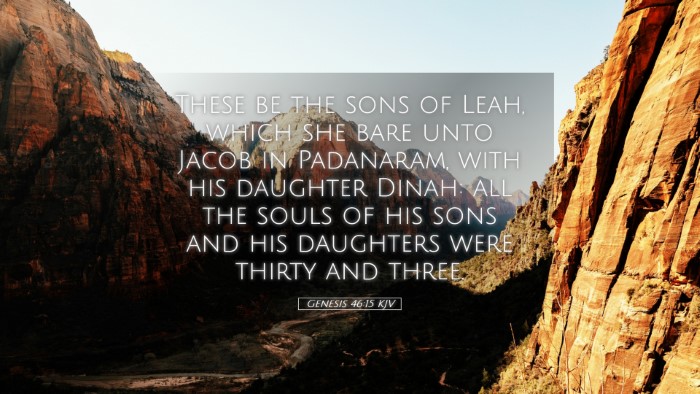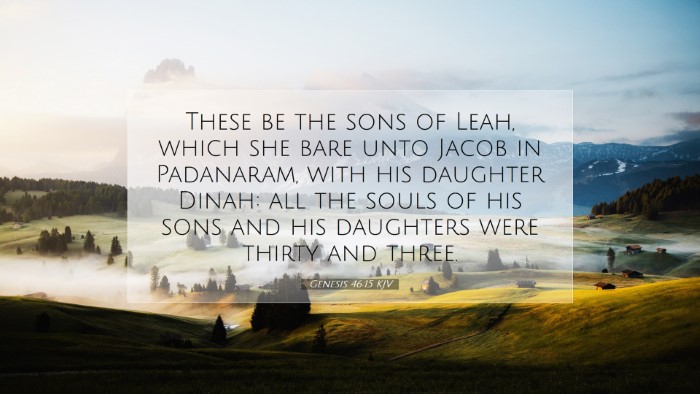Commentary on Genesis 46:15
Genesis 46:15 states: "These be the children of Leah, which she bare unto Jacob in Padanaram, with his daughter Dinah: all the souls of his sons and his daughters were thirty and three."
Overview
This passage serves as a pivotal point within the narrative of Jacob's migration to Egypt, emphasizing the lineage of Jacob, also known as Israel, through his marriage to Leah. The enumeration of his children highlights the growth of the nation of Israel and foreshadows significant future events. The mention of Leah's daughter, Dinah, amidst the context of sons fuels discussion about gender roles and inheritance within biblical tradition.
Insights from Matthew Henry
Matthew Henry remarks that this verse serves to demonstrate God's faithfulness in fulfilling His promises. Henry notes that Leah, though initially unloved by Jacob, was instrumental in bearing many of the tribes of Israel. He emphasizes that God's providence often includes the overlooked, in this case, Leah and her children. Henry asserts that the listing of the children not only reflects the fulfillment of God’s promises but also the burgeoning of a nation destined for greatness.
- God’s Providence: The faithful recounting of Leah’s children exemplifies God’s sovereign will in history. Every child is included, reflecting God’s acknowledgement of all His people.
- Inclusion of Dinah: The mention of Dinah serves a dual purpose; she is a significant character in her own right and highlights the importance of women in genealogical records, deviating from the strictly male lineage.
Insights from Albert Barnes
Albert Barnes offers a detailed analysis, suggesting that this genealogy serves not merely as a family record but as a theological statement about the establishment of Israel. Each name listed underscores the complexity of Jacob's family dynamics and also indicates an unfolding of God’s plan through familial ties.
- Theological Significance: Barnes notes the importance of the phrase "all the souls," indicating that every person mentioned carries weight in the larger narrative of God’s covenant people.
- Representation of Tribes: By cataloging these names, the text sets the stage for the future enumeration of the tribes of Israel, enriching the understanding of their identities and destinies.
Insights from Adam Clarke
Adam Clarke provides an exhaustive commentary that contextualizes this verse within the larger biblical narrative. Clarke emphasizes the importance of Leah in Jacob's life, noting that her children laid the foundation for several tribes. He draws attention to cultural implications inherent in the family dynamics, particularly the preference Jacob showed for Rachel over Leah, and how this affected their relationships and the sociopolitical landscape among their descendants.
- Cultural Context: Clarke reflects on the position of women during this period, underscoring how Leah's contributions, although less highlighted compared to Rachel, were equally vital for the theocratic lineage.
- Dinah’s Role: The mention of Dinah can be seen as a foreboding element, prefiguring future events in the narrative where her life becomes pivotal within the family saga.
Application for Modern Readers
The listing of Leah's children invites contemporary readers to consider the multifaceted roles individuals play within families and communities. As churches and communities often wrestle with legacy and identity, this passage encourages reflection on the contributions of all members, irrespective of their perceived status or primary roles.
- Valuing Every Member: The diversity of Leah’s offspring reminds us to value the contributions of all members within our communities, emphasizing that everyone has a role to play in God’s plan.
- Gender Dynamics: As modern readers delve into gender discussions, Leah's inclusion, alongside her daughter Dinah, reflects the biblical acknowledgment of women's significance in the narrative of God’s covenant.
Conclusion
Genesis 46:15 encapsulates not only the historical account of Jacob's children but also invites a deeper theological exploration of God's character and providence. Through the lens of several public domain commentaries, readers can discern how this genealogical record provides a profound understanding of familial importance, the roles of women, and the overarching narrative of redemption that unfolds throughout Scripture.


